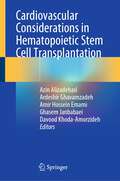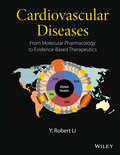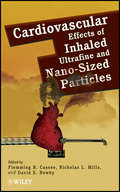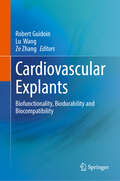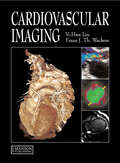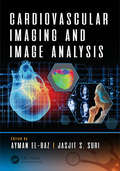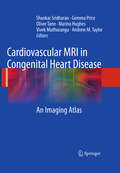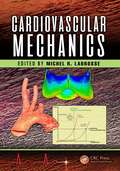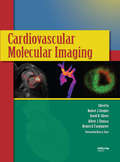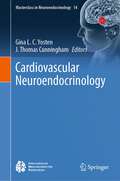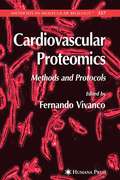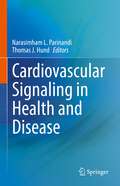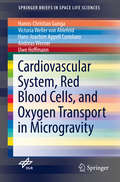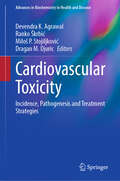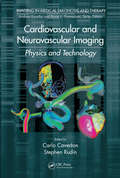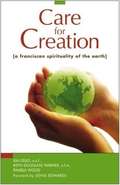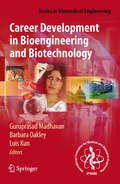- Table View
- List View
Cardiovascular Considerations in Hematopoietic Stem Cell Transplantation
by Azin Alizadehasl Ardeshir Ghavamzadeh Amir Hossein Emami Ghasem Janbabaei Davood Khoda-AmorzidehThis book discusses the epidemiology and the known cardiotoxic effects of chemoradiation agents in addition to newer therapies in hematopoietic stem cell transplantation (HSCT). Recent expert consensus statements from cardiology and hematology/oncology societies are reviewed in regard to risk stratification of the patient based on the type of treatments they are undergoing. Finally, gaps in knowledge are identified with proposed avenues of research that allow for more accurate risk assessment, prediction and potential treatment of the HSCT patient in attenuating the risk of developing cardiovascular comorbidities.Cardiovascular Considerations in Hematopoietic Stem Cell Transplantation reveals a picture of effective management of these patients in order to optimize both short- and long-term outcomes of HSCT. It is of considerable interest to all involved or training within this rapidly growing area of cardiology and oncology.
Cardiovascular Development: Methods and Protocols (Methods in Molecular Biology #843)
by Marc Antonyak Xu PengsCongenital heart disease is the leading cause of infant death and affects approximately one in every 100 babies born in the United States. The study of cardiovascular development has acquired new momentum in last twenty years due to the advancement of modern molecular biology and new available equipments and techniques. In Cardiovascular Development: Methods and Protocols expert researchers in the field in the field detail many of the methods which are now commonly used in the field of cardiovascular development research. These include methods and technique for using different organisms for cardiovascular developmental research, using cell and molecular biology methods to study cardiovascular development, as well as other available techniques for cardiovascular development research. Written in the highly successful Methods in Molecular BiologyTM series format, chapters include introductions to their respective topics, lists of the necessary materials and reagents, step-by-step, readily reproducible laboratory protocols, and key tips on troubleshooting and avoiding known pitfalls. Authoritative and practical, Cardiovascular Development: Methods and Protocols seeks to aid scientists in understanding new state-of-the-art techniques in the field of cardiovascular development research including in vivo imaging and Bioinformatics.
Cardiovascular Diseases
by Y. Robert LiWritten in an accessible style and consistent format, the book covers both the fundamentals and advances in the pharmacology of cardiovascular drugs, as well as their integrated applications in the management of individual cardiovascular diseases. * Integrates fundamentals and recent advances regarding cardiovascular drugs, blending basic and clinical sciences needed to effectively understand and treat cardiovascular diseases * Facilitates understanding of drug action and mechanism by covering physiology / pathophysiology and pharmacology * Includes guidelines and algorithms for pharmacotherapeutic management of cardiovascular diseases * Uses case presentations and study questions to enhance understanding of the material * Serves as a resource for pharmaceutical and medical students and researchers interested in cardiovascular issues
Cardiovascular Effects of Inhaled Ultrafine and Nano-Sized Particles
by Nicholas L. Mills David E. Newby Flemming R. CasseeThis book assists scientists, toxicologists, clinicians, and public health regulators to understand the complex issues that determine the impact of air pollution on the cardiovascular system. It covers a range of relevant topics including particulate matter (PM) sources and characterization, methods of exposure, impact of PM on cells and systems, role of particles in the pathophysiology of cardiovascular disease, risk assessment, and potential environmental and therapeutic interventions.
Cardiovascular Explants: Biofunctionality, Biodurability and Biocompatibility
by Lu Wang Ze Zhang Robert GuidoinThis book matches the most appropriate usage of implants commercially available with the indications for the operations based upon solid diagnostics. Topics covered include an in-depth analysis of the SETA-LATECBA stent-graft and the rapid maturation of stent-graft technology. The challenge of the RVOT reconstruction is also analyzed along with the investigation of vascular grafts at reoperation. Textile fabrics and material selection of heart valves is also covered, with a section devoted to how to prioritize material selection. This is an ideal book for students and surgeons studying medicine and biomedical engineering, industry professionals working in R&D, as well as regulatory agencies, such as the FDA, SFDA, and Bureau of Medical Devices.
Cardiovascular Function of Peripheral Dopamine Receptors (Clinical Pharmacology)
by J. Paul HiebleThis volume deals with the consequences of activation of peripheral dopamine receptors impacting on the cardiovascular system, either the prejunctional neuroinhibitory dopamine receptor or the postjunctional dopamine receptor. It is useful for cardiovascular clinicians and receptor specialists.
Cardiovascular Imaging
by Yi-Hwa Liu Frans WackersA host of imaging techniques are available to clinical cardiologists, including nuclear imaging, echocardiography, computerized tomography, and magnetic-resonance imaging. Chamber size, ventricular function, valvular function, coronary anatomy, and myocardial perfusion are among a wide array of cardiac characteristics that can all be assessed noninvasively.Cardiovascular Imaging systematically reviews each of these major techniques and provides clinical data from well-designed research studies. Following a brief overview of non-invasive cardiac imaging and the stress modalities used to detect coronary disease, case-based chapters are devoted to each of the various imaging techniques. The final chapter provides a glimpse of future possibilities, particularly with respect to molecular imaging. The text is illustrated throughout with amply-sized images.Demonstrating the values and limitations of the imaging techniques, the book enables practitioners to determine which test, in which patient population, and for which purpose would be the most appropriate to use.
Cardiovascular Imaging and Image Analysis
by Jasjit S. Suri Ayman El-BazThis book covers the state-of-the-art approaches for automated non-invasive systems for early cardiovascular disease diagnosis. It includes several prominent imaging modalities such as MRI, CT, and PET technologies. There is a special emphasis placed on automated imaging analysis techniques, which are important to biomedical imaging analysis of the cardiovascular system. Novel 4D based approach is a unique characteristic of this product. This is a comprehensive multi-contributed reference work that will detail the latest developments in spatial, temporal, and functional cardiac imaging. The main aim of this book is to help advance scientific research within the broad field of early detection of cardiovascular disease. This book focuses on major trends and challenges in this area, and it presents work aimed to identify new techniques and their use in biomedical image analysis. Key Features: Includes state-of-the art 4D cardiac image analysis Explores the aspect of automated segmentation of cardiac CT and MR images utilizing both 3D and 4D techniques Provides a novel procedure for improving full-cardiac strain estimation in 3D image appearance characteristics Includes extensive references at the end of each chapter to enhance further study
Cardiovascular MR Manual
by John Greenwood Sven Plein John P RidgwayThe aim of this book is to provide a compact text for practicing physicians and cardiologists or radiologists in training that contains all aspects of cardiovascular magnetic resonance imaging relevant for the appropriate use of this imaging modality in clinical practice. In a tutorial style, the book provides an overview of the relevant physics that govern CMR imaging and provide details on commonly accepted indications for referral. The book also provides the necessary background information to get trainees prepared for training in a CMR center. The emphasis of the book will be on practical, hands-on information in a format small enough to be carried about for ease of use. The book will be a dense but extremely portable reference for all cardiologists involved in using or requesting MRI of their cardiac patients. This will be an all-in-one resource and of great clinical value.
Cardiovascular MRI in Congenital Heart Disease: An Imaging Atlas
by Oliver Tann Gemma Price Marina Hughes Andrew M. Taylor Vivek Muthurangu Shankar SridharanThe interpretation of MR images of congenital heart disease can be difficult without previous experience or formal training. This book provides insight into specific, pathologic conditions along with key MR and CT images depicting the pathology with a clear interpretation. Each image is detailed and clearly labeled with a central key for the specific condition, allowing the reader to track anatomical structures through the separate imaging planes. A concise yet clear interpretation of each image is given to aid learning. The imaging planes and protocols used to obtain the images are presented, allowing the user to plan future MR studies of patients with similar conditions.
Cardiovascular Mechanics
by Michel R. LabrosseThe objective of this book is to illustrate in specific detail how cardiovascular mechanics stands as a common pillar supporting such different clinical successes as drugs for high blood pressure, prosthetic heart valves and coronary artery bypass grafting, among others. This information is conveyed through a comprehensive treatment of the overarching principles and theories that are behind mechanobiological processes, aortic and arterial mechanics, atherosclerosis, blood and microcirculation, hear valve mechanics, as well as medical devices and drugs. Examines all major theoretical and practical aspects of mechanical forces related to the cardiovascular system. Discusses a unique coverage of mechanical changes related to an aging cardiovascular system. Provides an overview of experimental methods in cardiovascular mechanics. Written by world-class researchers from Canada, the US and EU. Extensive references are provided at the end of each chapter to enhance further study. Michel R. Labrosse is the founder of the Cardiovascular Mechanics Laboratory at the University of Ottawa, where he is a full professor within the Department of Mechanical Engineering. He has been an active researcher in academia along with being heavily associated with the University of Ottawa Heart Institute. He has authored or co-authored over 90 refereed communications, and supervised or co-supervised over 40 graduate students and post-docs.
Cardiovascular Molecular Imaging
by Albert J. Sinusas Robert J. Gropler David K. GloverCardiovascular Molecular Imaging is based on a groundbreaking NIH symposium sponsored by the American Society of Nuclear Cardiology. The first all-inclusive guide to the targeted molecular imaging of the cardiovascular system, it includes color illustrations throughout and is packaged with a user-friendly CD-ROM with supplemental material.This refe
Cardiovascular Neuroendocrinology (Masterclass in Neuroendocrinology #14)
by Gina L. C. Yosten J. Thomas CunninghamThe cardiovascular system and the neuroendocrine system are integrated at multiple levels. This integration is key to normal physiological function. Further, it adapts to accommodate changes related to aging, the organism’s reproductive state, or physiological challenges. This type of adaptability, or plasticity, also can contribute to pathophysiology when these systems are stressed. This volume discusses how neuroendocrine systems influence cardiovascular function in health and disease. The first section provides detailed background information on neuronal and neuroendocrine control of cardiovascular function. This is followed by chapters highlighting the cardiovascular role of neuroendocrine hormones in regulating physiological states, such as pregnancy, and the effects of biological sex on vascular function. The influence of exercise, stress, psychology, and aging on cardiovascular function and dysfunction, and the possibility of therapeutically targeting the neuroendocrine axis for the treatment of cardiovascular disease are discussed in the final section of the book.This book is of relevance for students, trainees and established researchers alike who are seeking for an overview on the neuroendocrine control of cardiovascular function and disease. This is the fourteenth volume in the International Neuroendocrine Federation (INF) Masterclass in Neuroendocrinology series, which aims to illustrate the highest standards and encourage the use of the latest technologies in basic and clinical research and hopes to provide inspiration for further exploration into the exciting field of neuroendocrinology.
Cardiovascular Proteomics: Methods and Protocols (Methods in Molecular Biology #357)
by Fernando VivancoThis cutting-edge book presents protocols and strategies for proteomic evaluation of cardiovascular disease written by pioneering researchers in the field. Topics explored in this comprehensive volume include obtaining specific heart proteins, techniques for identifying risk biomarkers of atherome plaque rupture, analyzing the secretome of explanted endarterectomies cultured in vitro, and phage display techniques for deciphering the molecular diversity of blood vessels.
Cardiovascular Regenerative Medicine: Tissue Engineering and Clinical Applications
by Vahid Serpooshan Sean M. WuThis book is a comprehensive and up-to-date resource on the use of regenerative medicine for the treatment of cardiovascular disease. It provides a much-needed review of the rapid development and evolution of bio-fabrication techniques to engineer cardiovascular tissues as well as their use in clinical settings. The book incorporates recent advances in the biology, biomaterial design, and manufacturing of bioengineered cardiovascular tissue with their clinical applications to bridge the basic sciences to current and future cardiovascular treatment. The book begins with an examination of state-of-the-art cellular, biomaterial, and macromolecular technologies for the repair and regeneration of diseased heart tissue. It discusses advances in nanotechnology and bioengineering of cardiac microtissues using acoustic assembly. Subsequent chapters explore the clinical applications and translational potential of current technologies such as cardiac patch-based treatments, cell-based regenerative therapies, and injectable hydrogels. The book examines how these methodologies are used to treat a variety of cardiovascular diseases including myocardial infarction, congenital heart disease, and ischemic heart injuries. Finally, the volume concludes with a summary of the most prominent challenges and perspectives on the field of cardiovascular tissue engineering and clinical cardiovascular regenerative medicine.Cardiovascular Regenerative Medicine is an essential resource for physicians, residents, fellows, and medical students in cardiology and cardiovascular regeneration as well as clinical and basic researchers in bioengineering, nanomaterial and technology, and cardiovascular biology.
Cardiovascular Signaling in Health and Disease
by Narasimham L. Parinandi Thomas J. HundThis contributed volume focuses on cardiovascular diseases (CVDs), and explores the ways in which signaling mechanisms at the biochemical, molecular, and cellular levels in the blood vessels (vascular) and heart contribute to the underlying causes of development and progression of the CVDs. This volume covers unique topics such as oxidant signaling in vascular and heart diseases and health, cytoskeletal signaling in vascular health and disease, phospholipase signaling in CVDs, lipid signaling in vascular and myocardial health and diseases, and drug discovery in cellular signaling for cardiovascular diseases.This book assembles the most important discoveries made by leaders on the cellular signaling mechanisms operating behind the development and progression of life-threatening CVDs. It is an extremely useful resource for the investigators in the field of CVDs, and opens the discussion for further discovery of efficient management and effective treatment of the CVDs.
Cardiovascular System, Red Blood Cells, and Oxygen Transport in Microgravity (SpringerBriefs in Space Life Sciences)
by Hanns-Christian Gunga Victoria Weller von Ahlefeld Hans-Joachim Appell Coriolano Andreas Werner Uwe HoffmannThis book comprehensively describes the physiological changes and consequences that occur in humans during spaceflight. It specifically presents the adaptations of the cardiovascular and the respiratory system. Specific changes occurring after 10, 20 or more days in space are depicted. Furthermore, the book explains various effective countermeasures that are required upon return of the astronauts to Earth. The book is a must-have for all biomedical and clinical researchers in the field of cardiovascular biology and respiration, and a fascinating reading for all interested laymen, who wish to understand a bit more about spaceflight research and technology.
Cardiovascular Toxicity: Incidence, Pathogenesis and Treatment Strategies (Advances in Biochemistry in Health and Disease #33)
by Ranko Škrbić Devendra K. Agrawal Dragan M. Djuric Miloš P. StojiljkovićThe cardiovascular system is vital for human well-being, playing key roles in thermoregulation, nutrient transport, fluid balance, and protection from infection. Cardiovascular diseases are leading causes of morbidity and mortality. Pharmaceuticals, illicit drugs, toxins, and environmental factors can induce cardiovascular toxicity, causing structural changes and impairing blood flow. Co-morbidities like diabetes and obesity, along with epigenetic factors and infections, further enhance cardiovascular toxicity. Understanding these factors and developing better therapeutic approaches is crucial. New drugs and vaccines have improved disease treatment, but they can also induce adverse effects by affecting the endothelium, coagulation factors, platelet activation, oxidative stress, inflammation, baroreceptors, autonomic cardiovascular control, and electrophysiology. This issue has been overlooked for a long time but is now gaining attention. Expanding knowledge to the general population and health practitioners, increasing research activities, and developing better preventive and treatment strategies are essential. Cardiovascular adverse effects can be induced by various drug classes used in cancer treatment, infections, and other disorders. Understanding the mechanisms of cardiovascular toxicity and prevention methods is critical. This book, with 40 chapters contributed by distinguished scientists, explores these issues, highlighting knowledge gaps, future directions, and key points. Understanding the biological complexity and interactions between genetic and environmental factors is crucial for developing better therapeutic approaches.
Cardiovascular and Neurovascular Imaging: Physics and Technology
by Carlo Cavedon Stephen RudinCardiovascular and Neurovascular Imaging: Physics and Technology explains the underlying physical and technical principles behind a range of cardiovascular and neurovascular imaging modalities, including radiography, nuclear medicine, ultrasound, and magnetic resonance imaging (MRI). Examining this interdisciplinary branch of medical imaging from a
Care for Creation: A Franciscan Spirituality of the Earth
by Ilia Delio Pamela Wood Denis Edwards Keith Douglass WarnerThree of the greatest minds in Franciscan theology, Ilia Delio, O. S. F. , Franciscan Keith Douglass Warner, O. F. M. , and Pamela Wood, come together to discuss one of the greatest crises of our time--the destruction of the Earth. This book takes both a theological and practical approach to developing a Franciscan spirituality of the earth. Four sections highlight the distinct relationships creation has with the world: incarnation, community, contemplation and conversion. In this meticulously researched book, the authors propose ways in which we can all understand our own roles in relationship to the Earth and ways in which we can make it better. Each section offers reflective action opportunities designed to bring the book's ecological and theological insights into the reader's daily life and nurture a Franciscan spirituality of the earth. Prayers, meditations, spiritual practices and group activities are offered which provide a practical hands-on approach to reconnecting with the earth and acting in right relationship.
Care for Your Body (Health and My Body)
by Martha E. RustadFrom exercising to getting enough sleep, you are in charge of your body. It's important to take good care of it. Using informative text and vibrant photos, Care for Your Body reminds you of simple ways to keep your body healthy. Complete with a glossary, a read more section, kid-friendly Internet sites, and an index.
Care for Your Teeth (Health and My Body)
by Martha E. RustadSay cheese! Good dental hygiene is an important way to stay healthy. With engaging text and colorful photos, readers learn good habits for heathy teeth. Care for Your Teeth includes a glossary, read more section, kid-friendly internet sites, and an index.
Care of the Species: Races of Corn and the Science of Plant Biodiversity
by John Hartigan Jr.Across the globe, an expanding circle of care is encompassing a growing number of species through efforts targeting biodiversity, profoundly revising the line between humans and nonhumans. Care of the Species examines infrastructures of care—labs and gardens in Spain and Mexico—where plant scientists grapple with the complexities of evolution and domestication. John Hartigan Jr. uses ethnography to access the expertise of botanists and others engaged with cultivating biodiversity, providing various entry points for understanding plants in the world around us. He begins by tracing the historical emergence of race through practices of care on nonhumans, showing how this history informs current thinking about conservation. With geneticists working on maize, Hartigan deploys Foucault&’s concept of care of the self to analyze how domesticated species are augmented by an afterlife of data. In the botanical gardens of Spain, Care of the Species explores seed banks, herbariums, and living collections, depicting the range of ways people interact with botanical knowledge. This culminates in Hartigan&’s effort to engage plants as ethnographic subjects through a series of imaginative &“interview&” techniques.Care of the Species contributes to debates about the concept of species through vivid ethnography, developing a cultural perspective on evolutionary dynamics while using ethnography to theorize species. In tackling the racial dimension of efforts to go &“beyond the human,&” this book reveals a far greater stratum of sameness than commonly assumed.
Career Development in Bioengineering and Biotechnology (Series in Biomedical Engineering)
by Barbara Oakley Robert Langer Luis Kun B. Alberts Guruprasad MadhavanThis indispensable guide provides a roadmap to the broad and varied career development opportunities in bioengineering, biotechnology, and related fields. Eminent practitioners lay out career paths related to academia, industry, government and regulatory affairs, healthcare, law, marketing, entrepreneurship, and more. Lifetimes of experience and wisdom are shared, including "war stories," strategies for success, and discussions of the authors' personal views and motivations.
Career Opportunities in Forensic Science
by Susan Echaore-McDavid Richard A. McDavidMost people are familiar with the common image of the forensic scientist as depicted in popular television programs like CSI and in the movies. Yet forensic science is actually a complicated science based on the use of scientific principles and techniques to determine facts in legal disputes, resolve various types of investigations, and solve mysteries. According to the American Academy of Forensic Science, any science used for the purposes of law is a forensic science. Career Opportunities in Forensic Science includes a total of 82 job profiles in this exciting field. Extensive appendixes include education and training resources, certification program listings, professional associations, and more. Career profiles include: Accident reconstruction specialist Computer forensics specialist Crime scene investigator Criminologist DNA analyst Fire investigator Forensic engineer Forensic pathologist Forensic science researcher Forensic sculptor Medical examiner Prosecuting attorney and more.
